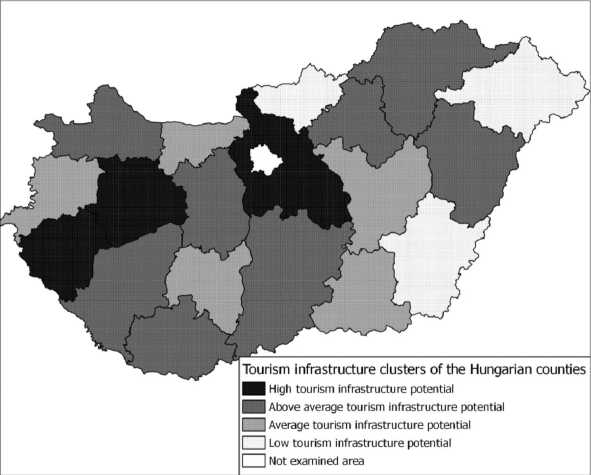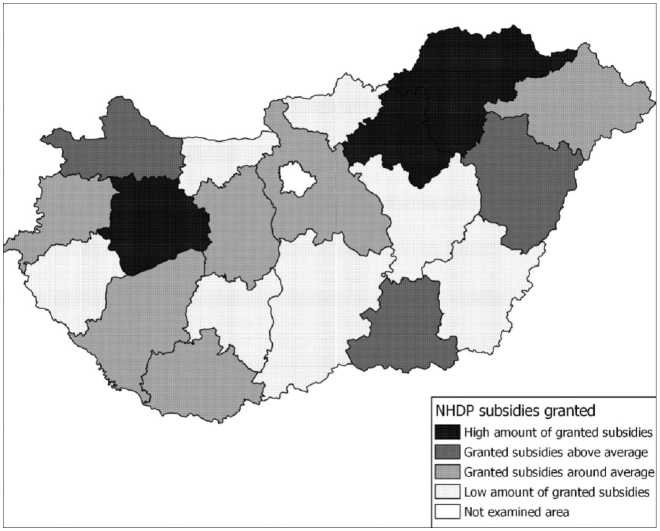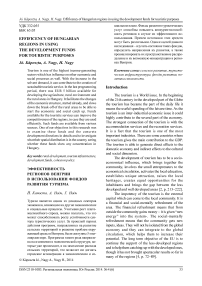Efficiency of Hungarian regions in using the development funds for touristy purposes
Автор: Kаposzta jО., Nagy А., Nagy Н.
Журнал: Региональная экономика. Юг России @re-volsu
Рубрика: Фундаментальные исследования пространственной экономики
Статья в выпуске: 4 (6), 2014 года.
Бесплатный доступ
Tourism is one of the highest income-generating sectors which has influence on other economic and social processes as well. With the increase in the solvent demand, it can contribute to the creation of sustainable touristic service. In the last programming period, there was EUR 5 billion available for developing the agriculture, rural environment and the rural areas in Hungary. It facilitates the changes of the economic structure, started already, and slows down the break-off of the rural areas to be able to start the economic and social catch up. Funds available for the touristic services can improve the competitiveness of the regions, in case they are used efficiently. Such funds are available from various sources. One of our objectives in this research was to examine these funds and the concrete development directions in details and to investigate what their spatial distribution is in the country, seeing whether these funds show any concentration in Hungary.
Rural development, tourism infrastructure, development funds, cohesion policy
Короткий адрес: https://sciup.org/149131046
IDR: 149131046 | УДК: 332.055
Текст научной статьи Efficiency of Hungarian regions in using the development funds for touristy purposes
The tourism is a World issue. In the beginning of the 21th century in the developed part of the Globe the tourism has became the part of the daily life it means the useful spending of the leisure time. As the tourism is an inter-industrial economic issue it could highly contribute to the several part of the economy. The strongest connection of the tourism is with the accommodation services and the recreation services. It is a fact that the tourism is one of the most important industries. There are some countries where the tourism gives the main contribution to the GDP. The tourism is able to generate direct effects to the domestic economy and indirect effects to the cultural and social dimension.
The development of tourism has to be a socioeconomical influence, which brings together the community, involves the small entrepreneurs to the economical circulation, activates the local education, establishes unique attraction, raises the local heritages, creates equal opportunities for the inhabitants and brings the gap between the less developed and well developed areas [2, p. 213–222].
The impotency of the tourism is the external capital which can come to the local community. It is a financial and social-mentally refreshment of the area. The financial refreshment means that from outside the community gains money – it is given “new energy” into the system-. The social-mentally refreshment means that the community gets new inputs, ideas. They will not be isolated from the global economy and they can integrate to the global circulation, which helps them to increase their potential. The long term objective of the EU is to continue the support of the less-developed regions and to help them catching-up with the developed ones, though it has not brought spectacular results so far in many of the regions [4, p. 72–89].
In order to realize the targets set in the National Development Plan (2004–2006) , five development plans have been prepared, including one with the comprehensive developments of the seven regions, called Regional Operation Program. This program included an individual priority called “Strengthening of touristic potentials”. The measures “Developing the touristic attractions” and “Improving the touristic attractiveness” greatly contributed to the promotion of the development of tourism sector.
The New Hungary Rural Development Strategic Plan contains the strategic frame of the Hungarian rural development, funded by the European Fund for Agriculture and Rural Development. Its aim is to create the development potentials to improve the agriculture, to preserve the natural values in the rural areas, to strengthen the rural economies as well as to achieve social cohesion. The funds that are for encouraging the touristic activities are available in the 3rd axis in the New Hungary Rural Development Program , financed by the European Fund for Agriculture and Rural Development. Out of the 4 axis, this represents 12 % of the funds, with a cofinancing rate of 75 %. The touristic potentials of the regions have been improved from the Regional Operational Programs of the National Development Plan and later on of the New Hungary Development Plan [3, p. 337–346]. The aim of the non-refundable funds is to create or preserve jobs in the rural areas, especially in relation to sustainable rural-, agro-, eco-tourism as well as promoting the marketing of related services. The New Széchenyi Plan has supported the touristical projects as well. Eligible developments include development of accommodation facilities, of business- and marketing activities as well as education and training.
Altogether 114 projects have been implemented in the regions, including HUF 30.07 billion funds. In Borsod- Abaúj- Zemplén county, 19 projects were realized from HUF 4.31 billion. It is interesting to see that e.g. Western-Transdanubia and Central-Transdanubia have not received such amount of funds. Most of the funds – total HUF 3.39 billion-was spent on “Development of world-heritage places and historical city centers with significant tourism potentials” in B-A-Z county, out of which Tokaj received almost HUF 3 billion. The rest of the funds was spent on the improvement of accommodations. The least fund was received by Tolna county until
2006. There were only two projects for improving the accommodation facilities in the Dombóvár micro region, accounting for HUF 0.05 billion.
Within the New Hungary Development Plan (2007–2011) all the seven regions had their own regional operational programs where tourism remained to be an important issue. In addition, the development of accommodation facilities, the development of attractions as well as the establishment of Touristical Destination Management organizations were among the priorities. 390 projects have been implemented so far, accounting for HUF 115.59 billion fund. In our study we focus on these funds due to the availability of data.
In January 2011, the New Széchenyi Plan replaced the former development plan. One of the important strategic directions, namely the Healing Hungary Health Industry Program , has the tourism development priority. In order to realize that priority, 603 projects gained funds of total HUF 130 billion. The number of projects implemented so far is 141, totaling of HUF 13.72 billion.
Material and methods
-
1. Data collection:
-
2. Statistical and mathematical calculation:
The research is based on secondary statistical data analysis and comparison. In the analysis, we defined five indicators, out of which 4 were applied to define the infrastructural potential of tourism and the last one describes the funds for touristic purposes. The data have been collected from TEIR database and from the National Development Agency (NFÜ) at county level. We have collected the data for 19 counties, excluding Budapest, since the capital does not belong to the convergence regions and is not eligible for touristic funds, therefore it is useless to include in the analysis.
As for the touristic funds distributed among the counties, we carried out our research based on the funds of the programming period of the New Hungary Development Plans as well as the figures for the year 2011.
The indicators involved in the analysis as follows:
-
1. In the case of time-optimization, the fastest route to the highway conjunction in minutes.
-
2. The number of catering facilities.
-
3. The number of nights spent at commercial accommodations + other (nights spent at private accommodation until 2009).
-
4. The number of cultural events.
-
3. Mapping the results:
After homogenizing the abovementioned indicators, we compared them to the touristic funds approved. We need to emphasize that the research in its starting phase so we have compared only these four indicators so far. The number of indicators will be increased in the further phases of the research, adding economic, social and environmental indicators. In order to examine the coherences, we needed to create indices from the data available.
To illustrate the regional differences the mapping method is one of the most common methods. In this research two maps have been created to understand the disparities.
Results and discussion
The abovementioned indicators have been transformed with mathematical methods and we created partial indices from the figures for all the counties these partial indices have been summed and their average has been calculated, which we named as infrastructural potential index of tourism . With using the minimum and maximum values, we calculated the deviation of the index and created four categories [1].
Based on the indicators we can state that Pest, Zala and Veszprém are in the best position (Figure 1). The reason for their favourable position is the proximity of Budapest and the Lake Balaton, adding that Zala is close to the Western border too. Several former researches justify that the two most popular and preferred destinations in the country are Budapest and the surrounding area of Lake Balaton. Therefore these counties have high touristic potentials.
The next cluster consists of 8 counties, with indicators above the average (0.31). They have one feature in common causing their good position, namely that their partial index regarding accessibility is good, meaning that the highway conjunction in the county can be reached in short time. In Borsod-Abaúj. Zemplén county the index is high due to the effect of funds spent within the National Development Plan for the preservation of worldheritage and the use of funds for the improvement of accommodation facilities and services. These counties have touristic potentials above the average whose impact on other sectors cannot be forgotten. We have found average values in 5 counties, out of which Tolna is closer to the areas lagging behind. Despite its extremely good accessibility partial index, that of the number of catering facilities and nights spent is quite low. From touristic infrastructure potential aspect, Békés, Szabolcs-Szatmár-Bereg and Nógrád counties can be considered counties lagging behind. According to the indicators, these counties require complex touristic developments, since all the important touristic partial indices are very low.

Fig. 1. Tourism infrastructure potential index in Hungary
Source: own editing, based on NDA and TEIR data (2011).

Fig. 2. The amount of NDA subsidies in Hungary from 2007 to 2011
Source: own editing based on NDA and TEIR data (2011).
Funds
After analyzing the indicators and defining the categories, we considered it important to examine the funds for 2007–2011 period.
As Figure 2 shows, the highest amount of funds for touristic purpose was granted to Borsod-Abaúj-Zemplén, Heves and Veszprém counties. Based on the indicators mentioned above, the infrastructure potential of tourism in all these counties was extremely good or above the average in line with the high amount of touristic funds.
Relatively high funds could be used by Csongrád, Győr-Moson-Sopron and Hajdú-Bihar counties as well. However, there are 7 counties which received very low funds for touristic developments, including Zala county , which is very surprising, since it has outstanding infrastructural potential based on the indices. One reason can be that the existence of basic touristic infrastructure does not involve high funds. However, Veszprém county had good indices and received high funds. It can be stated that Nógrád county is a county lagging behind from touristic potential point of view because the potential is the lowest there and receives low amount of funds as well. Consequently, the county needs basic economic, social and infrastructural developments more than touristic ones.
Conclusions
Overall, it can be concluded that high amount of touristic funds were received by counties which are easily accessible, are close to highways, therefore a territorial concentration can be observed along the M1, M6, M7 and M3. We can observe that the counties with the poorest results regarding tourism infrastructure are either far from the highways (Békés) or have poor quality of infrastructure and low economic and social activity (Szabolcs-Szatmár-Bereg and Nógrád), however the latter one is not far from the capital but there are tiny settlements that are isolated from the others.
We can also state that even if economic indicator was not included among the indicators examined, there is a strong correlation between the economic development level of the area and the infrastructure potential . We can assume that infrastructure potentials are better where the economy is more developed due to the higher demand for touristic services and the availability of solvent market.
It is also interesting that from the 3 counties with the lowest potentials (Békés, Szabolcs-Szatmár, Nógrád) only Szabolcs-Szatmár could gain relatively high funds compared to the other two which means that it stepped on the path of tourism development even if the amount was still below the average, but the others can be considered unsuccessful in this matter. Consequently, they are in difficult situation, since with their low potentials in line with low amounts of funds, they need much more efforts to catch up with the others. In our opinion, Nógrád should take advantage of its proximity from the capital and to build on the local resources and traditions. The activity of Tolna in gaining funds should also be accelerated, due to its characteristic settlement-system consisting of tiny settlements with good natural endowments but poor economic and social background as well as low interest by foreign direct capital.
In addition, it is clear that even if some counties belong to the same cluster, their strengths regarding infrastructure potentials in tourism are not the same, they are in good positions due to various reasons. In our further researches we wish to examine in details what factors influenced the favourable indices of the counties and what factors missing from the counties with poor performance in tourism. With our researches we intend to examine what factors are required and what resources are necessary in a county for the development of tourism.
Список литературы Efficiency of Hungarian regions in using the development funds for touristy purposes
- Goda P. Új rendszerszemléletű helyzetfeltárási módszer a vidéki területek fejlesztésében, doktori (PhD) értekezés. Gödöllő, 2012, ðð. 34-45.
- Goda P., Nagy A. Regional analysis of the developement actions of tourism between 2007 and 2010 in the NHDP. Cross-border initiatives to facilitate economic and social developement in the V4 countries and in Ukraine. June 2-4 2010. Szent Istvan University Gödöllő, Hungary, pp. 213-222.
- Kassai Zs., Ritter K. Helyi vidékfejlesztési programok a hátrányos helyzetű vidéki kistérségekben. "Gazdálkodás" 55. Évfolyam 4. Szám., 2011, pp. 337-346.
- Ritter K., Kulcsár L. (ed.). Socio-economic development and employment crisis in agriculture in Hungary. Regional aspects of social and economic restructuring in Eastern Europe: The Hungarian Case. Budapest, 2010, pp. 72-89.


